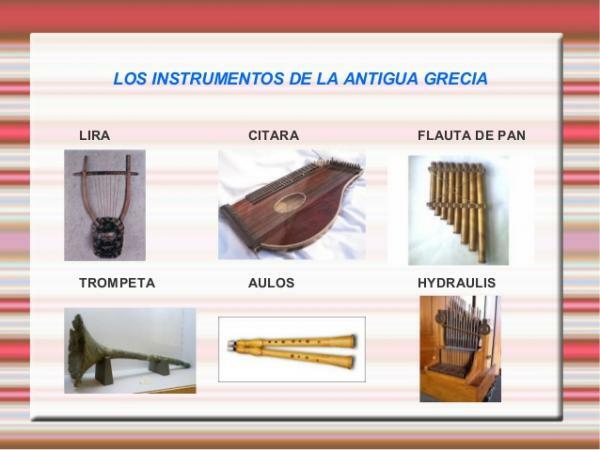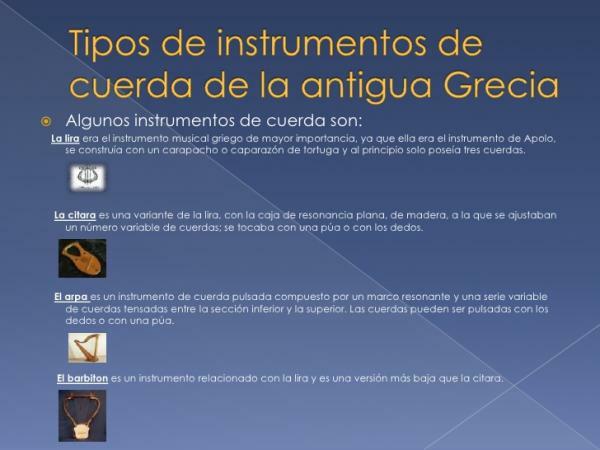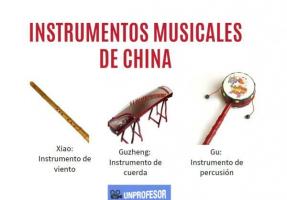List with the musical INSTRUMENTS of ANCIENT GREECE

Image: Slideshare
It is always very useful and interesting to learn about the origins of the artifacts and inventions that we use today. As in many other cases, to learn more about musical instruments we must revisit history. In this lesson from a TEACHER we will talk about the instruments of Ancient Greece to know these objects that have transcended in the production of sound and whose bases remain even after more than 3,000 years.
When we speak of Ancient Greece we refer to the European area during the period of history from the year 1,200 a. C. until the year 146 a. C., year of the Roman conquest. Even so many years later there are fragments of musical notation from this time and this is how we get a small sample of how music could sound back then.
The Greeks were polytheists (they believed in many gods) and frequently resorted to symbolism. The word itself "music" actually comes from the Greek word "Muses", that mythologically they are the daughters of the god Zeus and that they had the power to inspire all creative and intellectual activities.
The Greeks were arduous thinkers who valued both science and art and are in fact responsible for many of sound studies that gave us musical foundations (eg Pythagoras with sound proportions). The Greeks they had musical scales, from which come the "greek modes”That are still used today, including the provenance of the larger scale.
Next, we are going to discover in detail which are the most popular Ancient Greek instruments at the time and which, some of them, are still used today. They are as follows.
Aulos
It was kind of oboe double a wind instrument with two tubes with holes (from 3 to 6) that had a double reed, just like the oboe of today. The instrument also existed in Rome and was called “tibia”. This instrument was related to the cult of the gods Dionysus and Cibeles, who represent pleasures and fertility.
Avicinio
It was also one of the most prominent Ancient Greek instruments and it included a wind instrument, a type of toy. The avicinio was shaped like a bowl made of zinc, which had a water container and had tubes made of clay at its ends. Thanks to its curious mechanics, it was able to reproduce sounds that resembled different birds.
Lira
It's a plucked string instrument played with both hands, from which comes the harp, guitar, zither and lute. Its shape resembles an abacus, since the instrument itself is a representation of the God Hermes, deity of rhetoric and commerce. Furthermore, the Lyre was a symbol of music, culture, religion and science. Other ancient Greek instruments are assimilated to the lyre, such as the barbiton or phormix.
Chelys
It was a plucked string instrument that had a resonance box originally made with a tortoise shell and skin stretched over it. The instrument has two wooden rods that hold another rod in turn, in which the strings are placed to tighten them. The chelys is frequently depicted on Greek vessels and is a variation of the lyre. Another similar but larger instrument is the Kithara.
Zither
Another plucked string instrument similar to the lyre. It was associated with the cult of Apollo (god of the arts), and therefore it was considered more noble than other instruments such as the aulos that we have mentioned. The word "guitar" comes from the word "zither".
Create them
Also calls believe them,they are a kind of Greek castanets. It is a percussion instrument that comes in pairs to be played with the hands and fingers, colliding with each other to create the sound. They were used to keep the rhythm during dances and festivities such as weddings and were generally played by women.
Pan flute
It is a wind instrument made up of several hollow reed tubes arranged in a row, open at one end and covered at the other. It is named after the Greek god "Pan". Some instruments today descend from this, such as the zampoña or siku, common South American areas such as Bolivia and Peru.
Tambourine
It's a percussion instrument simple in principle, with a wooden frame, or two superimposed, which is covered with taut skin, of animal origin (often sheep). The tambourine does not have a certain pitch and is played with the fingers and hand.
Pandura
It uses the principles of operation that we know of the guitar today, with a neck and frets, which differentiated this instrument from lyres and harps. The number of strings varied but it was usually made with 2 or 3. Its name refers to Pandora, the first woman according to Greek mythology.
Salpix
It is a wind instrument of the trumpet family. The salpix was a very long tube with a tapered end. It was made of bronze or ivory and was used mainly for military purposes.
Monochord
An instrument with a single string (hence its name monkey, which means "unique" and cordial, of "rope") whose invention is attributed to the philosopher Pythagoras. Its main function was to investigate the properties of sound in relation to the proportions of the string, which would serve to establish principles of tuning and musical intervals.
How can you observe the ancient greek instruments play an important role in the musical legacy that has developed to this day, contributing with many principles and foundations of the same music that is part of our lives nowadays. It is always very interesting to refer to the origins of something to have a deeper understanding of the way some things are.

Image: Slideshare



